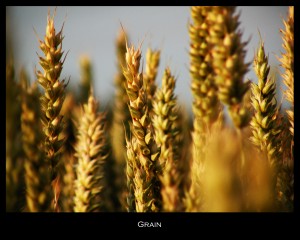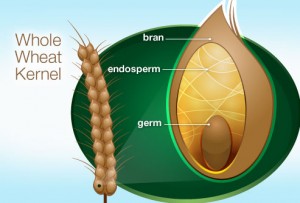I always tell people that is completely possible to go vegan and still eat terribly. We are lucky in this day and age to have vegan convenience foods that can make life easier, but they also allow for the possibility of the “junk food vegan”. To truly gain all the benefits of being vegan, you’ll want to keep those as occasional splurges, and focus on eating a whole foods, plant-based diet. One of the biggest keys to that, and to making the mental shift, is looking for whole grains.

By permission from Creative Commons, original here
White flour (and similarly white sugar, white rice, etc) is wheat with all the nutrients removed. It makes it soft and fluffy and … empty. White flour is basically empty calories, and as good for you as eating straight sugar, since those empty carbs turn into sugar almost immediately in your system and spike your insulin levels. Whole wheat flour, on the other hand, is made from the full wheat grain. The wheat grain has 3 main parts, the bran, germ, and endosperm, and almost all of the fiber and nutrients live in the bran and the germ. They contain the minerals zinc, magnesium, and manganese, and plenty of vitamins, particularly important B vitamins, such as folate, thiamin, and vitamin B6, just to name a few. In order to make white fluffy flour manufacturers strip out the bran and the germ, leaving only the nutrient deficient endosperm. Whole wheat flour retains the whole grain (hence the name!), and all the fiber and nutrients with it. This makes it have a much lower glycemic impact, as well as all the benefits of the fiber and other nutrients.

From WebMD
Now you might say, “but my pasta/bread/cookies are enriched/fortified with lots of nutrients!” But here’s the thing. Putting nutrients back in is never going to have the same effect as just leaving them in in the first place. Eating the whole food encompasses a myriad of nutrients, and we haven’t begun to identify all of them. Which means that when we put them back in, we leave so many out. And for the ones we have identified, we know that we don’t even come close to knowing how they all work together, so isolating them and adding them back to a food can’t possibly replicate the impact they have when working as nature provides them originally.
So this world of “enriched” and “fortified” products provides us great practice in reading labels. When a bread/pasta/cake/whatever says it’s “whole grain” or “multi-grain” – CHECK the ingredients list. In most cases, this means it has some percentage of whole wheat flour, or flours from another grain, but is still majority basic white flour. If a label says “100% whole grain” – awesome. Sometimes whole grain breads will have more than 50% whole grains – but still not 100%. Reading labels this way can seem like a pain, but I think it’s really good practice. If you get into that habit it means you are being more conscious of paying attention to whether you’re eating a whole food in one place in your diet – and the more you do it in one place, the more it will carry over everywhere. The more it carries over everywhere, the more eating whole foods becomes a way of life – which is exactly what we want. :)
I have focused here on whole wheat, since wheat flour is what we encounter every day, but this of course applies to other grains as well. As with everything, the more variety of foods you eat the more variety of nutrients you are consuming, so try out all the grains out there! Stick to the whole grain versions of rice (brown rice), barley, rye, buckwheat, millet, oats, bulgur, and you’ll find the ones you love.

